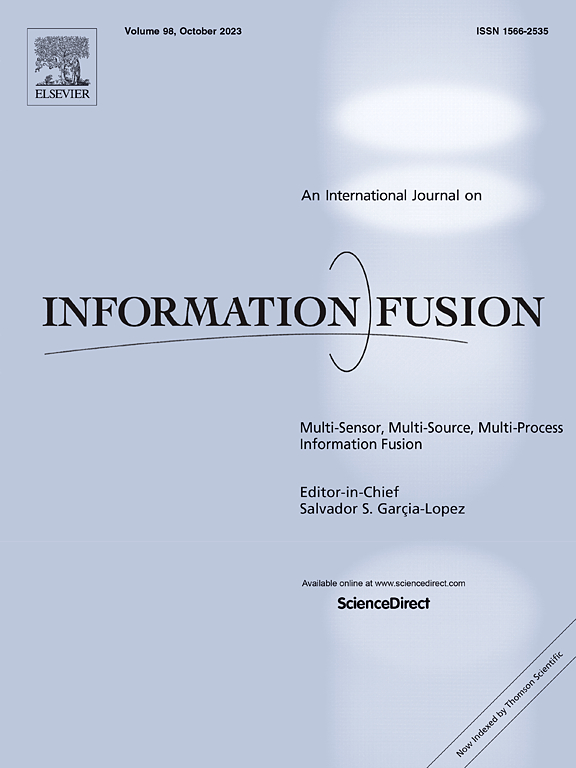基于关系融合的超图神经网络增强小样本时空预测
IF 14.7
1区 计算机科学
Q1 COMPUTER SCIENCE, ARTIFICIAL INTELLIGENCE
引用次数: 0
摘要
时空预测是智慧城市应用的一项关键服务,例如交通和空气质量预测。深度学习模型被广泛应用于这一任务,但现有方法的有效性在很大程度上取决于来自城市传感器的大量数据。然而,在智慧城市发展的早期阶段,由于从新部署的传感器收集到的数据有限,数据稀缺构成了重大挑战。此外,由于严格的隐私政策,从其他资源丰富的城市传输数据通常是不可行的。为了应对这些挑战,我们提出了一种基于关系融合的超图神经网络(RFHGN),用于少样本时空预测。RFHGN 直接在一个城市的有限数据上进行训练,利用多种空间相关性和分层时间依赖性来丰富时空表征。具体来说,为了增强空间表达能力,我们设计了一个具有自适应时变超图结构的高阶空间关系感知学习模块。这种结构是通过整合观测数据来学习的,并在训练过程中不断更新,从而能够捕捉动态的高阶交互。通过将这些交互作用与成对空间表征相结合,我们得出了混合阶空间表征。为了减少潜在的冗余,我们引入了正则化的独立性损失,以确保成对空间表征和高阶空间表征的独立性。此外,为了有效捕捉微观和宏观层面的时间依赖关系,我们开发了分层时间关系感知学习模块。在交通流量、交通速度和空气质量预测这三个时空预测任务上的广泛实验表明,RFHGN 的性能优于最先进的基线。本文章由计算机程序翻译,如有差异,请以英文原文为准。
Enhancing few-sample spatio-temporal prediction via relational fusion-based hypergraph neural network
Spatio-temporal prediction is a pivotal service for smart city applications, such as traffic and air quality prediction. Deep learning models are widely employed for this task, but the effectiveness of existing methods heavily depends on large amounts of data from urban sensors. However, in the early stages of smart city development, data scarcity poses a significant challenge due to the limited data collected from newly deployed sensors. Moreover, transferring data from other resource-rich cities is typically infeasible because of strict privacy policies. To address these challenges, we propose a relational fusion-based hypergraph neural network (RFHGN) for few-sample spatio-temporal prediction. RFHGN is trained directly on limited data within a city, exploiting multiple spatial correlations and hierarchical temporal dependencies to enrich spatio-temporal representations. Specifically, to enhance spatial expressiveness, we design a high-order spatial relation-aware learning module with an adaptive time-varying hypergraph structure. This structure is learned by integrating observational data and is iteratively updated during training, enabling the capture of dynamic high-order interactions. By combining these interactions with pairwise spatial representations, we derive mixed-order spatial representations. To reduce potential redundancy, we introduce a regularized independence loss to ensure the independence of pairwise and high-order spatial representations. Additionally, to effectively capture temporal dependencies at micro and macro levels, we develop a hierarchical temporal relation-aware learning module. Extensive experiments on three spatio-temporal prediction tasks: traffic flow, traffic speed, and air quality prediction demonstrate that RFHGN outperforms state-of-the-art baselines.
求助全文
通过发布文献求助,成功后即可免费获取论文全文。
去求助
来源期刊

Information Fusion
工程技术-计算机:理论方法
CiteScore
33.20
自引率
4.30%
发文量
161
审稿时长
7.9 months
期刊介绍:
Information Fusion serves as a central platform for showcasing advancements in multi-sensor, multi-source, multi-process information fusion, fostering collaboration among diverse disciplines driving its progress. It is the leading outlet for sharing research and development in this field, focusing on architectures, algorithms, and applications. Papers dealing with fundamental theoretical analyses as well as those demonstrating their application to real-world problems will be welcome.
 求助内容:
求助内容: 应助结果提醒方式:
应助结果提醒方式:


